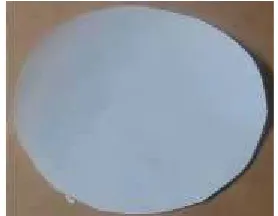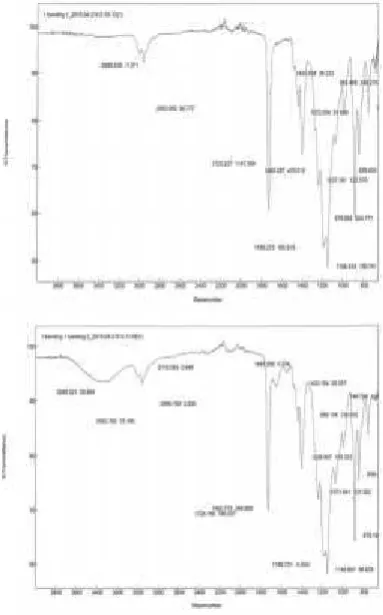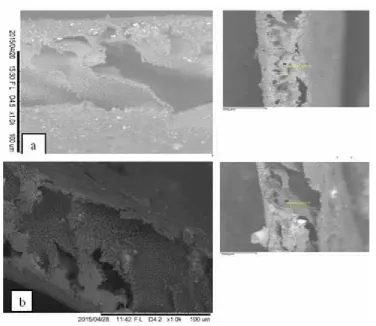Jurnal Natural
Vol. 18, (1) 2018DOI 10.24815/jn.v18i1.8023
Published February 2018 pISSN 1411-8513eISSN 2541-4062
EFFECT OF BENTONITE AS FILLER IN COMPOSITE
MEMBRANE
PERFORMANCE
POLYVINYLIDENE
FLUORIDE
(PVDF)-POLYMETHYLMETHACRYLATE
(PMMA)
Erda Marniza
1, Marlina
2, M.Nasir
31
Master’ s Program of Chemistry, Syiah Kuala University, Jl. Tgk. Chiek Pante Kulu No.5
Darussalam, Banda Aceh, 23111
2
Department of Chemistry, Faculty of Mathematics and Natural Sciences, Syiah Kuala
University, Jl. Tanoh Abe No.3 Darussalam, Banda Aceh, 23111
3
Research Center of Chemistry, Lembaga Ilmu Pengetahuan Indonesia (LIPI) Bandung,
Jl. Cisitu-Dago, Bandung, 40135
*corresponding Author E-mail : [email protected]
Abstract. The effect of bentonite as filler on the performance of the composite membrane of PVDF-PMMA
has been performed. This study was conducted to determine the performance PVDF-PMMA composite membranes and membrane applications PVDF-PMMA-Bentonite on oily wastes. Bentonite is obtained from North Aceh while PVDF membrane-PMMA by phase inversion method. This study uses an oily waste water model was made by mixing surfactant tween 80 with concentration of 2% with palm oil and gas oil. Membrane PVDF-PMMA-Bentonite is analyzing using cell ultrafiltration (flux test), FTIR and SEM-EDX. The results showed that the value of flux with the addition of bentonite is greater than without bentonite. Good flux values contained in the PVDF-PMMA-Bentonite (1:1:2) amounted to 32.143 L/m2.h.bar with permeability of 21.428 L/m2.h. FTIR characterization analysis results show that bentonite can add to pore at wave number 1520 cm-1and 1660 cm-1SEM and EDX results showed regular shape and uniform pore.
Keywords: Membrane, bentonite, filler, FTIR, SEM-EDX, Oily wastewater
I INTRODUCTION
Membrane technology is broadly used for drinking water desalination, waste cooking oil processing, medical purposes, and gas separation in chemical industry. Moreover, it is also applied in the field of alternative energy which is a basic part in fuel cell. Supplying membrane for chemical uses is a major challenge in the membrane study field. Generally, membrane can be created from organic and inorganic compounds. Furthermore, the most important point is that membrane does not have negative impact to the environment because separating process by using membrane does not need additional chemical compound. Polyvinylidene flouride (PVDF) can be used as a material in making process of membrane. PVDF is a polymer with high polarity and electrolyte absorbent [3]. A shortfall of PVDF is that it has high crystallinity such that the produced membrane is fragile and easily broken. However, the high crystallinity of PVDF can be decreased through blending method which is a simple method to modify the polymer matrix.
Some polymers such as polyethylene oxide
(PEO), polyacrylonitrile (PAN),
polydimethylsiloxane (PDMS), and polymethyl methacrylate (PMMA) have been used as PVDF matrix mix [4]. In this research, PMMA was used to create composite together with PVDF. PMMA has characteristics which are like transparent plastic, have good collision strength and temperature resistance. PMMA membrane has low stereoregularity making it amorf, resistant to aqueous inorganic reagent including alkali and acid. Utilized of PVDF-PMMA membrane was also conducted by Ochoa et al.,[3]. They investigated the
increase the hardness and the elastic modulus, modify the values of the strength, toughness, stability, heat and electricity conductivity [4].
Bentonite is a good absorbent. The existence of pore space between the clay mineral bonds and unbalanced electrical load in the ions makes bentonite beneficial as excavation trench for many purposes [5]. The effort in separating oil-water emulsion is not yet optimally carried out. In order to support it, this research concerns on
developing PVDF-PMMA composite
membrane by adding the bentonite as the filler. The addition of bentonite is expected to increase the membrane’ s performance resulting high flux value and rejection coefficient. The produced membrane was characterized by evaluating its flux value, FTIR, and SEM-EDX. Furthermore, membrane in the optimum condition was tested against the oil emulsion separation. The produced membrane has been applied to resolve the environmental contamination. The oil contamination in low or high concentration has happened as a serious problem. Therefore, this research is an effort in creating a technology for solving the separation problem in low-cost and easy way as well as without further impact [6].
II METODOLOGY
The materials which were used in this research
are bentonite, aceton, PVDF
(polyvinylidenefluoride), PMMA (polymethyl
methacrylate), DMAc (N-N
dimethylacetamide), dextran, H2SO4, aquades, oil waste, gasoline, and tween 80.
Bentonite activity
Natural bentonite in the form of boulder was broken up by using porcelain and then sieved to produce particles of 170 mesh. Bentonite powder was put into HCL of 10 mL and stirred by using magnetic stirrer on a hot plate for 2 hours at temperature of 40oC. Thereafter, it was washed and filtered with aquades up to pH>4. The filtrate was discarded while the wet bentonite sediment was dried in the oven at temperature of 105oC for 4 hours hence the pure bentonite was obtained. The resulting bentonite was not characterized but it was directly used to make membrane.
Composite membrane of PVDF-PMMA-bentonite variation
PVDF-PMMA-bentonite membrane was
producing based on the research conducted by Ochoa [3]. In the research, it used phase inversion method by dissolving PVDF and PMMA with and without adding the bentonite
in DMAc solution as much as 10 mL. The solution was stirred by using magnetic stirrer until it become homogeneous at temperature of 40oC. Furthermore, dope solution was poured on rectangular glass plate and set aside for 60 sec at room temperature. This step aimed to let the solvent evaporate. Hereafter, soaking process was taken in the coagulation tub containing aquades for 24 h and then it was stored for membrane’ s performance test.
Membrane’ s performance test
Membrane’ s performance test was carried out through evaluating the flux by using ultrafiltration module. The test was conducted in the chemistry laboratory of LIPI (Lembaga
Ilmu Penelitian Indonesia), Bandung. In the
working system of ultrafiltration module, a feed (water) was inserted in the ultrafiltration module by using the funnel pipette with a small hole of diameter 0.5-2 mm at pressure of 0.1-5 bar, then the stirring rotation was set until it was stable. Permeate would come out through the bottom hose while the retentate would remain stuck in the ultrafiltration module.
III RESULTS AND DISCUSSION
Membrane synthesis
Table 1 Comparison of various concentrations of PVDF-PMMA-Bentonite variation
PVDF:PMMA:Bentonite
(% b/b) PVDF PMMA Bentonite Visual Properties of Membrane
7:3:0 1.19 0.51 0 Thin, hydrophobic, white, smooth, glossy 7:3:1 1.19 0.51 0.2 Thin, hydrophobic, white, smooth, less shiny
7:3:2 1.19 0.51 0.4 Thick, hydrophobic, white, slightly rough, less shiny
7:3:3 1.19 0.51 0.6 Thick, hydrophobic, white, slightly rough, less shiny
1:1:0 0.85 0.85 0 Thin, hydrophobic, white, smooth, glossy 1:1:1 0.85 0.85 0.2 Thin, hydrophobic, white, smooth, less shiny 1:1:2 0.85 0.85 0.4 Thin, hydrophobic, white, smooth, shiny 1:1:3 0.85 0.85 0.6 Thick, hydrophobic, white, slightly rough
The hydrophobic property in this research came from C-F bond in the stable PVDF polymer structure. Visually, among the resulting membranes before and after the addition of
bentonite, PVDF-PMMA membrane at
concentration of 1:1:2 (% b/b) with the addition of bentonite at 0.4 was the finest with thickness at 0.015 mm. The produced membrane was white, had smooth surface, and shined as shown in Figure 1. This result happened because of complete interaction between the polymer and the bentonite or compatible (even) intermixture.
Figure 1 PVDF-PMMA-Bentonite membrane
Membrane’ s performance
In this research, the membrane’ s performance was determined through the flux and selectivity parameters by counting the rejection coefficient (R). The value of flux of the PVDF:PMMA membrane of 1:1 (% b/b) without bentonite was 0.848 L/m2.h, after the bentonite was added the flux decreased as much as 3.957 L/m2.h, while the value of flux of the PVDF:PMMA membrane of 7:3 (% b/b) was 0.329, after bentonite was added it became 0.019 L/m2.h (Table 2). This happened because the bentonite had filled the PVDF:PMMA membrane’ s pores such that water would not easily pass it and the flux rate became smaller. This result resonances what was stated by DPU (1983), which is that filler would fill the pores among particles in order to reduce hollow spaces and increase the density and stability of mass [8].
The rejection coefficient was determined by dextran break-out test at molecule mass 19.500, 506.000 g mol-1. The rejection coefficient value has purpose to evaluate the membrane’ s
performance in restraining the dissolved particles. Small rejection coefficient shows big sized pores. Ultrafiltration membrane should have high value of the rejection coefficient (R) to make a perfect separation process. Therefore, bentonite is a suitable filler to be used in the ultrafiltration membrane because bentonite is a crystal in the form of powder such that the surface area would be wider. High rejection coefficient (R) via dexstran on molecule mass
of 506.000 g/mol was at
PVDF:PMMA:Bentonite variation 7:3:2 (% b/b), which was 82% with flux 0,019 L/bar.m2 and variation 1:1:2 (% b/b) is 83% with flux 0.072 L/bar.m2.
L/m2h to 4.9 L/m2h but the constant flux had not reached yet at 60 min. According to Mahmud [3], the decreasing on flux is caused by clogged membrane’ s pores due to micro particulate matter such that it causes fouling and more compacting to the membrane’ s structure, which restrains the streaming feed from passing through it. Therefore, from these two variations, PVDF-PMMA-Bentonite membranes of 1:1:2 (% b/b) and 7:3:2 (% b/b), the membrane of 1:1:2 (% b/b) would be used to the oil-water emulsion test.
Figure 2 Water flux with respect to time.
Figure 3 Relationship between pressure and volume of oil wasted and gasoline.
Figure 3 exhibits that increases on the pressure cause decreases on the flux of the oil wasted and gasoline. The flux of the oil wasted which was initially at pressure of 0.5 bar decreased from 4.2 mL to 2.1 mL as the pressure increased, while gasoline decreased from 5 mL to 3.5 mL. The flux decrease happened due to the interaction between the membrane and the hydrophobic property of the oil-water emulsion, the size of emulsifier molecules were smaller than the size of membrane’ s pores such that it caused fouling on the membrane. Hydrophobic membrane was polar such that emulsifier molecules would be more strongly absorbed by water than by oil. Therefore, the surface tension decreased more such that the water could be easily passed through the membrane’ s pores. If high pressure was applied then the streaming rate of the waste oil and gasoline passing through the membrane’ s pores at high speed would cause more accumulated oil drops, whether on the surface or on the membrane, which resulted pore clogging or concentration polarization. Concentration polarization caused a decrease on flux as the pressure increased [9].
Analysis of function cluster
Characterization using FTIR aims to analyse the function cluster of the membrane with and without the filler (bentonite). Resulting FTIR spectrum can be observed in Figure 4. It shows the comparison of FTIR spectrum from PVDF-PMMA membrane without and with the addition of filler (bentonite).
Figure 4 Spectrum of FTIR of PVDF-PMMA membrane without bentonite (up) and with bentonite (down)
FTIR spectrum shows no significant difference but only on some peaks which present absorption at wave numbers 1520 cm-1 and 1660 cm-1. This results agree with the one based on a research conducted by Upriatna and Pramono (2005) stating that vibration at wave numbers of 1500-1700 cm-1showed interaction between inter-layer phase and bentonite. Wave number of 1520 cm-1is extended peak of Si-O or Al-O from the bentonite, while wave number of 1660 cm-1is crumpled peak of H-O-H from the water molecules absorbed in the bentonite’ s surface. Based on the FTIR spectrum, it can be learned that bentonite fill the PVDF-PMMA membrane in inter-layer phase way, which is interaction between PVDF-PMMA membrane and active side of the bentonite. The occurrence of new absorbing peaks shows that the bentonite has successfully filled the PVDF-PMMA membrane such that it can be filler on the PVDF-PMMA membrane.
Flu
ks
(L
/m
2.h
)
Figure 5 Surface structure of composite PVDF:PMMA membrane (a) without bentonite (b) with bentonite
Membrane’ s morphology
Results of Scanning Electron Microskop (SEM) with 1000 time magnification shows that there is difference between cross sections of the PVDF-PMMA membrane without filler and with the bentonite filler (Figure 5). On both figures, it can observed the difference in surface structure and density of the pores, Figure (5b) shows bigger hole than Figure (5a), this is due to that bentonite consists of Si and Fe elements, but clumps in the Figure (5b) are decreasing compared to the ones in Figure (5a), it is caused by wide pore surface of the bentonite.
CONCLUSION
Bentonite can be used as filler which takes role to increase the performance of PVDF-PMMA
membrane. PVDF-PMMA membrane has
optimum properties visually and
characteristically. PVDF-PMMA membrane has good performance at membrane composition of 1:1:2 (% b/b) which gives flux value of 0.848 L/m2.h and rejection factor of 82.631% without addition of bentonite and flux value of 0.072 L/m2.h and rejection factor 83.058% with addition of bentonite. Characterization of PVDF-PMMA membrane with bentonite by using FTIR shows that bentonite fills the PVDF-PMMA membrane in inter-layer phase
way which is interaction between PVDF-PMMA membrane and active side of the bentonite. It is indicated by the absorption at wave number 1520 cm-1 and 1660 cm-1which comes from the bentonite. The SEM-EDX analysis result shows that PVDF-PMMA membrane after the addition of filler (bentonite) has asymmetrical shape and smooth surface.
REFFERENCES
1. G L Ji, B K Zhu, Z Y Cui, C F Zhang, Y Y Xu 2007 PVDF porous matrix with controlled microstructure prepared by TIPS process as polymer electrolyte for lithium ion battery, Polymer 48 6415–6425. 2. Li H Y M Chen, X T Ma, J L Shi, B K Zhu,
L P Zhu 2011 Gel polymer electrolytes based on active PVDF separator for lithium ion battery. I: Preparation and property of PVDF/poly(dimethyl siloxane) blending membrane. J. Membr. Sci. 379 397–402. 3. Mahmud. 2006. Processing of Peat Moss
Water to Drinking Water by Using Hybrid Precoagulation Ultrafiltration Process with Dead End Streaming System. Jurnal Teknik
Lingkungan Edisi Khusus, Bandung.
application opportunities Materials Research, 12 (1), 1-39.
5. Gustam L 2008 Bentonite as Industrial Staple in North Sumatra. Inovasi, 5(3) 183 –188.
6. N Awanis Hashim, Fu Liu K Li 2009 A simplified method for preparation of hydrophilic PVDF membranes from an amphiphilic graft copolymer. J. membrane
science 345, 134-141.
7. Ochoa N M, Masuelli J, Marchese 2003 Effect of hydrofilicity on fouling of an
emulsified oil wastewater with
PVDF/PMMA membranes, J. Membran.
Science. 226, 203–211.
8. DPU 1983 Manual of Implementation of Thin Layer Concrete Asphalt (Flexible) (Lataston)No.12/PT/B/1983, Departemen Pekerjaan Umum Direktorat Jendral Bina Marga, Jakarta.
9. Hua F L, Y F Tsang, Y J Wang, S Y Chan, H Chua, S N Shin 2007 Performance of study ceramic microfiltrasi membrane for oily wastewater treatment. J.Chemichal


